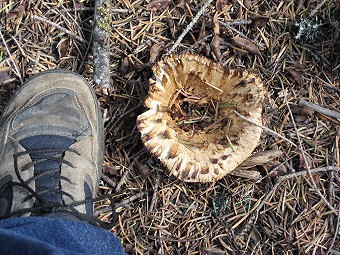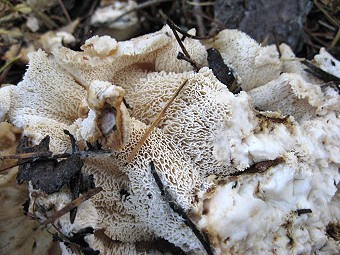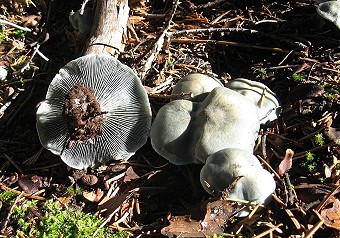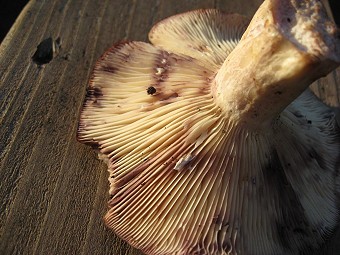|
Twenty-first Issue,
Fall 2007
Click on any picture to see a larger image This Fall season seemed about a month behind schedule, and in Greenville, came to late to produce many King or Queen Boletes. This year however, I identified a few species new to me, including the Bondarzewia montana and the Merulius (Phlebia) tremelosus, and with some help, finally added the correct species name to a polypore that I had found in November of 2004, a Coriolopsis trogii. Findings, September 9 to December 5, 2007 Sunday, September 9: Today we took a drive up to Lassen Volcanic Park mainly just for the drive. However, on the way towards Summit Lake, we spotted several large Ganoderma oregonens, and stopped only to take a photo > Saturday, October 28: After deciding there may never be any fall fungus up here near our home in Greenville, other than lawn mushrooms, we decided to try a little farther south and at a higher elevation. So we went up towards 5000 ft. today to check a few of our old "spots". No Boletus edulis found there, but we did see lots of Gomphus bonari (some very large), a few mature Ganoderma oregonense (quite small considering the date), a tan ramaria, some unidentified polypores, and a few other colorful mushrooms. The big surprise was finding what I think was a Boletus mirabilis, the first I have ever seen in the Sierras. Most likely it was a B. zelleri, but different than any I had ever seen before. We had it for dinner and the taste was very good, kind of lemony. Follow-up: After discussing my find with several others, I decided it WAS a zelleri, however large. On the way back to the car, as we crossed a creeek, we saw lots of dead fish along the shore and in the water. Looking closer, we saw lots of live activity in the water and it turned out to be hundreds of spawning salmon. Another new site for us. One polypore looked like an Albatrellus, the other, I have not even tried to ID to genus yet. The links to all of the pictures, including two movies of the spawning salmon, can be seen at fungus/. With the fall color display, a nice lunch at the restaurant near the south entrance to the lake, and finally finding some mushrooms, it was indeed a great day. Follow-up #2: Has anyone looked at the second polypore pictures I took near Buck's Creek and have any idea what it is? I tried my polypore key in Demystified, but couldn't seem to find anything that fit. It was about 8" across, hugging a rotting stump, soft, and had mazelike pore tubes. (see update below)I found it hard to think it was even a fungus, at first glance. Very close by, on a tall Red Fir snag, were a few small Ganoderma oregonense. In addition, I just got a spore print, and the spores are white, round, about 6 microns wide, and with short spikes or bumps. I broke it across and it seemed like a tight bunch of short funnels (1 1/2" long"), with the outer surfaces having the mazelike pore tubes. Finally: I got the following from Fred Stevens, and I think he is right, especially after looking at some pictures at Mushroom Observer, http://mushroomobserver.org/observer/show_name/478. (The spores DID have the amyloid reaction.)
Tuesday, October 29: I finally found a few mushrooms close to town that weren't on a lawn. At 3600 ft., I only found a solitary Man on Horseback (Tricholoma flavovirens) where I usually find several, plus very few LBMs, but at 4400 ft., I finally found a few large and fresh white chanterelles (Cantharellus subalbidus). It was a pleasant and welcome surprise after the long wait. No boletes yet, but lots of smaller, colorful mushrooms scattered the forest floor. I will probably recheck the general area in a few days, take more pictures, and post any that look interesting. I still have hope! Friday, November 2: I went back to one of my chanterelle spots at 4400ft, to see if I could find more. I did NOT find any white chanterelles, but did find a few other species. I found my first (for this area) pink-capped Gomphidius subroseus, a gorgeous couple of false chanterelles (Hygrophorus aurantiaca), what looked like a Suillus lakei, a large Deer Mushroom (Pluteus cervinus), a large orange coral mushroom (Ramaria sp.), and saw lots more colorful mushrooms beginning to carpet the forest floor. I also saw some large Gomphus bonari. The season up here seems to be moving along slowly, so I have renewed hope for the upcoming days. Monday, November 5: As the season may be peaking in
the Bay area, it seems to have finally This afternoon, while walking around in the forest, I saw my first mound by the side of the road. This mound yielded a small group of Agaricus praeclaresquamosus. The second mound revealed a few orange-topped corts. The third mound, however, turned out to be hiding a pair of small Queen Boletes. I also found a few Suillus under some small mounds and a small group of the striking Armillaria albolanaripes under another. I continued to search, hoping for more boletes, but found none. I am still very happy though. I hope the snow is held back for a few weeks longer to allow the bolete season to continue in the area, so I can use MY drier again. Sunday, November 11: Today Cecelia and I went to our local Boletus spot and found a few more Queen Boletes, one being very large but worm-free. After picking those and searching the area for awhile, we went up towards Lake Almanor to pick some Shaggy Manes, and then we continued to search around the immediate area. We were pleasantly surprised at the variety we found: some rather large Boletus zelleri, gemmed puffballs, lepiotas, a patch of the green, anise-scented Clitocybe odora, Russula brevipes, Tricholoma flavovirens, a group of polypores of some kind, and various other colorful mushrooms. It seems like the recent rains may have helped some. You can see most of the pictures I took listed (some enhanced for focus) at fungus/11-11-07/ Wednesday, November 15: Two days ago I went up to my boletus spot at 4400 ft, but found none. I did see lots of groupings of colorful mushrooms, a pair of the scaly chanterelle, Gomphus bonari?, a small grouping of Pine Spikes, Chroogomphus vinicolor, and another mysterious polypore. The spores of the "polypore" were white and tiny, around 1.5 x 4-5 microns, maybe slightly amyloid, and sausage-shaped. No idea what it is. Tomorrow I will take a close-up of the dried spore producing surface. The list of the links to the other pictures can be seen at fungus/11-13-07/ Follow-up: I finally decided to ID it as a Merulius (Phlebia) tremelosus, after a few other comments and viewing some other pictures on the Internet. Thanks to everyone for the leads. Another mystery solved! Today I checked my boletus spot at 3600 ft. but only found a few Queen boletes. But I also found a small grouping of the Man on Horseback (Tricholoma flavovirens), lots of Suillus fuscotomentosus, and lots of the striking Agaricus praeclaresquamosus, both almost everywhere. The Tricholoma I cooked up immediately to make sure what they were and dried the boletes, as we will be leaving soon for Thanksgiving, and we have plenty already cooked for that. We will probably have the Tricholoma tonight. The list of pictures of the Man on Horseback can be seen at fungus/11-15-07/ Saturday, November 17: Today Cecelia and I had a very nice day hunting mushrooms with some new friends, a couple who have property at Forest Ranch. He had been given my name by Charmoon Richardson when Charmoon had been asked if he knew of anybody living near the area who might be able to help the owner identify the mushrooms growing on his property. Thanks Charmoon, for getting us together. So after deciding via several email exchanges with the owner that he had found many of which I had identified as Boletus appendiculatus, we arranged to spend part of today with them. On the way to their house, we stopped and
gathered a few Shaggy Manes (Coprinus comatus) in all stages of development.
Right after we got there, I showed them how to clean and cook them, and with
lunch, we each enjoyed a small slice of bread covered with Shaggy Manes.
Good way to taste them for the first time. As we walked around the area, we saw lots of bumps, each hiding a new surprise. Right out of their driveway, we found several bright yellow Rhizopogons, probably young R. ochraceorubens. Soon, we starting finding lots of Russula brevipes and both Lactarius rubrilacteus and deliciosus (red and orange latex). We saw a few different inocybes, cortinariuses, and different colored russulas; red, cream-colored, yellow/purple, and everything in between. I showed them how to help the identification process by smell and taste, and in doing so, we actually found a few R. xerampelina (Shrimp Russula). One of the lactarius we picked later stained its flesh purple, so I named it as one of the L. uvidus group. I think we also may have found some Boletus truncatus. The more we walked, the more mounds we saw, and finally, in the oak leaves, started finding lots of Butter Boletes, the Boletus appendiculatus. This was a first for me, as I have only found our spring variation up here near Greenville, growing under conifers. We also found a few yellow amanitas. As we came back to the house, we found some hygrocybes that looked like the H. conica but didn't stain black, some small honey mushrooms growing out of the side of a bank, and some Gomphus that had faded to a dirty white, but I was told they have been much more orange when fresh. In that stage they looked like the G. kauffmanii to me. It was a great day, finally meeting our new friends in person and also finally finding LOTS of mushrooms, in just the couple of hours we walked and talked. When I got home I cooked up a small appendiculatus, and it seemed to have a slightly different taste than the ones up here that I have been calling Spring Appendiculatus (actually, the B. abieticola). It could have been because I didn't add any salt this time. You can see most of the pictures we took at images_2007/11-17-07/ I didn't take very many this time, as I was pretty busy picking. Tuesday, November 28: Yesterday, after a week of being away from home, I went back to my local Queen Boletus spot at 3600 ft. and found 4 more, 2 medium and 2 large, all of which showed some signs of freezing. One of the largest ones looked like it had already thawed and been re-frozen. I also saw lots of frozen suilluses, corts and russulas. I would guess that probably ends the season up here at 3600 ft and above. It has been VERY cold at night. However, I made a huge pot of mushroom soup using the one good large bolete, and we both thought it tasted pretty good! Recipe (modified for all cooked and chopped fresh boletes) is at Breitenbush 2005 Recipes. Monday, December 3: Today it warmed up a bit, so I went back to my Queen Boletus spot and searched around the area. I didn't see any at first, but did notice many mushrooms that were not frozen. This encouraged me to continue, but I was on my way back to the car when I spotted 3 large and familiar mounds. Each contained a very large boletus, and these boletes, because of the lighter color and total lack of a white bloom, I would ID as the Boletus edulis, The King! And I had thought it was going to be an edulis-less year up here again! Each showed some result of the colder weather. One was almost perfect with a small sister right next to it, the second was a little more damaged, the third, a lot. I think the thicker duff saved much of them. I dried them all. Got 6 trays worth. If it does not snow there tonight, I may even go up to 4400ft. and try my luck at an old edulis spot. Wednesday, December 5: Today, I took a chance and went up to the bike path along Lake Almanor (at 4400 ft), and actually found some oyster mushrooms that were not too bad, considering all the freezing temperatures we have had recently. Cecelia made some fritters with them that I thought tasted pretty good. A Recipe for Marinating Shiitakes, from Sam Longmire (top)
Preparing Chicken-of-the-Woods, from Sam Longmire
|




